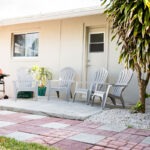Recovery residences, often referred to as sober living homes or transitional living environments, play a vital role in helping individuals maintain sobriety following treatment for substance use disorders. These supportive living arrangements provide a structured, substance-free environment that encourages personal responsibility, accountability, and long-term recovery.
Unlike inpatient treatment centers, recovery residences typically do not offer clinical services on-site. Instead, they serve as a bridge between intensive treatment and independent living, giving residents the opportunity to apply the skills they’ve learned in treatment while continuing to receive support from peers and house management.
These homes vary in structure and services, ranging from peer-run households to more formal residences with full-time staff and recovery programming. Regardless of the level of support, the ultimate goal remains the same: to foster stability and prevent relapse during one of the most vulnerable phases of recovery.
The Need for Stability in Early Recovery
Early recovery is a critical period when individuals are at increased risk of relapse due to psychological, emotional, and environmental stressors. Returning immediately to their previous living situation may expose them to old triggers, unhealthy relationships, or environments that do not support their sobriety.
Recovery residences offer a buffer from these challenges by providing a safe, stable space where residents can focus on rebuilding their lives. This stability allows them to establish new routines, develop healthy habits, and build a support system rooted in recovery values.
A secure living environment also reduces external stressors, giving individuals the mental and emotional space they need to strengthen their coping mechanisms. When basic needs such as housing and safety are met, individuals are more likely to succeed in maintaining their recovery efforts.
Core Features of Recovery Residences
Although the structure of recovery residences can differ, several key features are commonly shared across most programs. One of the most important elements is a commitment to sobriety. Residents are required to abstain from drugs and alcohol, and regular testing helps ensure accountability.
Community support is another central feature. Residents often participate in regular house meetings, share responsibilities such as chores, and support one another through the ups and downs of recovery. This peer-driven approach promotes mutual encouragement and reinforces the sense of belonging.
Many recovery residences also encourage or require participation in outside recovery meetings, therapy sessions, or vocational programs. This emphasis on continuing care and personal development helps residents transition toward long-term independence.
Levels of Support and Structure
Recovery residences are often categorized into different levels based on the amount of structure and support provided. These levels, recognized by organizations such as the National Alliance for Recovery Residences (NARR), range from peer-managed homes to clinically supervised facilities.
At the more autonomous end, Level I residences are often democratic, peer-run homes where residents are responsible for maintaining the property and supporting one another. These homes work well for individuals with a strong foundation in recovery who are ready for more independence.
Level II and III homes offer more structure, with a house manager or paid staff member on-site and possibly some recovery-related services. These environments provide a balance of independence and oversight, suitable for individuals who still benefit from some guidance.
Level IV residences provide the highest level of support, often including professional clinical services and more intensive programming. These may resemble treatment centers in some ways but still maintain a focus on community living and peer support.
The Importance of Community in Recovery
Isolation can be a major barrier to sustained recovery. Recovery residences counter this by offering a built-in community of people who share similar experiences and goals. This sense of camaraderie can be incredibly therapeutic, especially for individuals who may have lost social connections during their active substance use.
By living with others who are also working to stay sober, residents can learn from one another, share challenges, and celebrate successes. The collective wisdom within the household can be a powerful motivator and reminder that lasting change is possible.
This community aspect also provides accountability. When each resident is held to the same expectations and standards, it encourages responsibility and reinforces healthy behaviors.
Rebuilding Life Skills and Routines
Addiction often disrupts basic life skills such as budgeting, time management, personal hygiene, and interpersonal communication. Recovery residences offer a safe space to rebuild these skills without the chaos or pressure of navigating the outside world alone.
Daily responsibilities such as chores, curfews, and job searches help reintroduce structure into residents’ lives. These routines may seem simple, but they are instrumental in restoring a sense of normalcy and self-efficacy.
By practicing self-discipline and consistency in a supportive environment, residents prepare themselves for the challenges of independent living. These life skills are not only vital for staying sober—they’re essential for achieving personal goals and maintaining long-term well-being.
Reducing Relapse Risk
Relapse is a common concern for individuals transitioning from treatment back into everyday life. The temptation to return to old habits or social circles can be strong, particularly when faced with stress or uncertainty. Recovery residences mitigate this risk by providing an environment that prioritizes sobriety and accountability.
The structure of these homes, combined with peer support and ongoing engagement in recovery activities, serves as a buffer against relapse triggers. Many recovery residences also have clear consequences for relapse, which further reinforces commitment to sobriety.
For those who do slip, being in a recovery-focused environment often means receiving immediate support and guidance rather than facing relapse alone. This responsive, non-punitive approach can help residents course-correct quickly and continue progressing in their recovery.
Employment, Education, and Personal Growth
Another way recovery residences promote stability is by encouraging residents to pursue goals outside of maintaining sobriety. Many homes require residents to be employed, enrolled in school, or actively volunteering. This expectation helps instill a sense of purpose and fosters financial independence.
Pursuing education or employment during recovery can restore confidence, build new skills, and create a sense of identity beyond addiction. Recovery residences often offer guidance on resume building, job searches, and interview skills to support this aspect of personal development.
The structure and accountability provided in these homes also create a strong foundation for residents to focus on long-term planning. Whether it’s continuing education, rebuilding family relationships, or saving for future housing, residents are encouraged to invest in a life beyond their addiction.
Long-Term Stability and Success
Staying in a recovery residence is not a one-size-fits-all solution, nor is it meant to last forever. However, for many individuals, these homes provide the crucial stepping stone needed to stabilize their recovery and build a foundation for long-term success.
Some residents may stay for a few months, while others remain for a year or more depending on their needs. What matters most is the progress made during that time—emotionally, mentally, and practically. Each day spent in a recovery-focused environment strengthens the ability to navigate life with clarity and resilience.
When used as part of a broader continuum of care, recovery residences are one of the most effective tools available for sustaining sobriety and preventing relapse. By promoting consistency, community, and personal growth, these homes serve as a cornerstone of recovery that can influence lifelong outcomes.
Embracing Supportive Environments
A supportive environment can mean the difference between short-term recovery and lasting transformation. Recovery residences provide not just shelter, but a community of accountability, purpose, and hope. They give individuals the chance to reclaim their lives, one day at a time, in a space that understands the challenges and victories of recovery.
For anyone seeking a path to stability and long-term wellness, exploring recovery residence resources may be a meaningful and empowering next step. Call us today at 833-285-1315.













